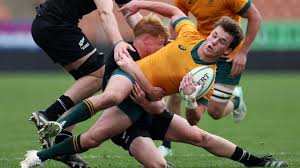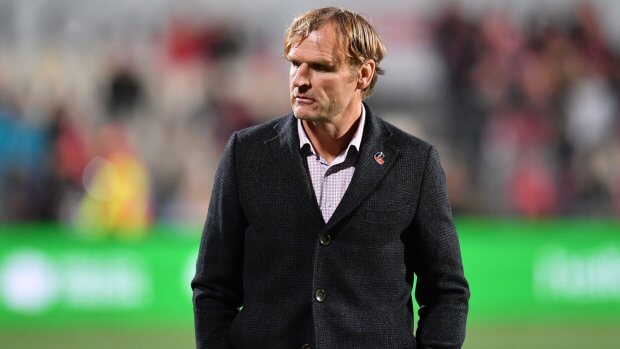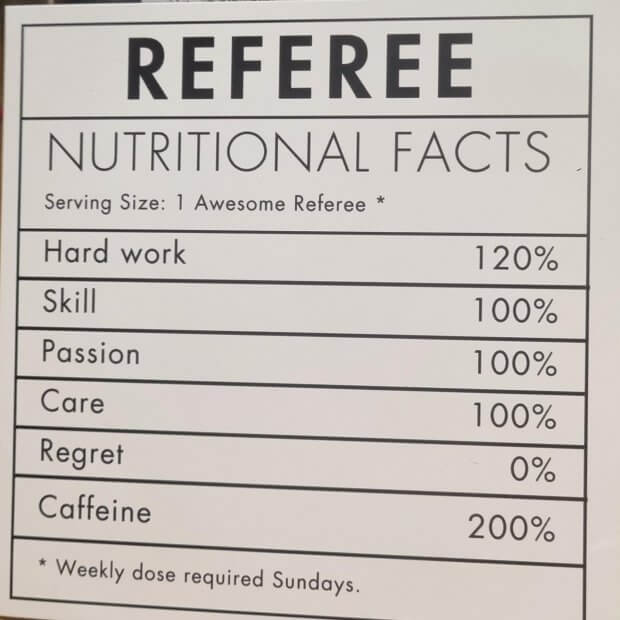Welcome fellow G&GRs. It’s that time of the year when we can sit back and review where things are at and start looking forward to the upcoming November tours. TBH, I find this time of the year pretty ordinary and most of the rugby news seems to be click bait designed to get people talking more than of real interest to me. However, here we are so let’s move on and make the best of it.
Referee Corner
Not a lot to report on here but I’ve been thinking about some of the issues that I’ve seen or been part of. One of the biggest ones for me is when a commentator starts questioning the scrum decisions and saying things like “How can he see to call that?” or “The scrum is a mess and the referee is guessing.” or ” The referee go that wrong!” The last one bugs me the most because so many supporters pick up on it thinking that somehow these ex-players must know more than the professional referee who does this for a living, and then join in with the abuse against the referee when they don’t actually know themselves what the issue was or that the commentator is incorrect.
When I first took up refereeing some 14 or 15 years ago the two biggest lessons were, firstly, how much running a referee has to do in a game. And secondly, how many of the laws I just had no clue about. I’d started playing at about age 6 and this was some 35 years later so I’d had a fair bit of experience myself with the game and yet still realised how little I knew of the laws, and more importantly, how they were applied. So let’s look at the process during a scrum and what the referee is looking at during this process. I expect a lot of previous or current props and hookers will have their own opinion on this and as I’m always learning please let me know where else I can approach this area.
Firstly, make a mark where the scrum is to be set and get the front rows setup. Here you are making sure that they aren’t too far apart so that they don’t lean in off their feet when they come together, or that they’re too close and so can’t create the gap you need. The hooker must have his break foot out and once they form up the second row then comes in and gets set. I don’t usually bother with the individual binding unless I see an issue developing in future scrums. Then we get the call “CROUCH!” Here I’m looking to make sure that the front row go down and wait until they are steady (so no foot movement or wiggling around). I make sure the front rows have their heads above the waist at this point and aren’t looking at going down into the bind but will either go straight in or slightly up. Also looking at the 8s to make sure they aren’t trying to “shot clock” into the locks and that both flankers have a full arm bind.
When ready we call “BIND!”. On bind I’m primarily looking for the props getting a good bind on the opposition and that it’s at the side not over the top. If one or more is struggling I’ll restart the setup and talk to them about making sure they both allow the opposition to bind. For some reason there’s always the odd player who seems to love making it hard for the opposition to get a bind which is just dumb. Once they have the bind I want to see them all push back and create that gap between the front rows. I make sure the hooker still has his break foot out, the flankers are angled straight and not out and that the 8 has got a bind on the scrum and not pulling the locks back ready to charge in. I also look to the backs making sure the defenders are at least 5 metres from their No 8.
Again, once they stop shuffling their feet and are still I then call “SET!”. Before the game I’ll speak to the front rows and one of the things I say is that if they want to win the hit then they can. But, they must win it then stop as they can’t keep pushing until the ball is put in. So at this point both front rows want dominance by hitting as hard as they can (generally) and setting their scrum steady while at the same time disrupting the opposition. The main things I’m looking on at the set is that the LH is up and straight (so head above the waist and not angling in) and that the TH is up and not heading down. Again I have to wait until things are steady and that neither team is pushing the other team off the mark. Once I’m satisfied I’ll step back and allow the half to put the ball in. Now I don’t worry too much about Kieth’s pet peeve of the ball not being straight. As I tell each team I have much more important things to look at, however if a 9 complains I’ll watch the next one and if it’s not under the shoulders of the front row then I’ll go straight to a short arm free kick.
When the ball goes in my main focus is looking at the props and where they’re going. Are any angling in? And if so, is it affecting the scrum? Are they keeping their shoulders high and not pulling the opposition down on one side? Usually the first arm down is the one doing the pulling as it’s hard to force a prop down while keeping your shape. Are their bodies staying straight and not lifting or trying to lift the opposition? Are they staying bound and maintaining contact with their opposition? Are they remaining up and on their feet and do their knees go down at all? If so, it’s usually on the less dominant side. If the scrum starts moving, is it a dominant move that is pushing one back and if so is it staying straight? Is one team walking back or trying to spin the scrum? Usually you can see this as the prop causing it will change their body shape to make the direction. Are the locks staying low and not sliding up the front row and are they staying straight?
At the same time I’m looking at the opposing 9 to make sure they take up the correct position. Either staying at the mid scrum or moving to the back but staying close to the scrum or going right back to the 5 metre line. Are the flankers staying straight and not boring in to change the scrum direction? Has the 8 changed from between the locks to between a flanker and a lock and has this affected the scrum movement? Then as the ball comes back or the scrum moves, are the backs still 5m back and moving with the scrum, especially on the flanks and blind side?
Once the ball gets to the back I start looking at the props again and who’s controlling the scrum and are they trying to influence the outcome by either causing the scrum to collapse, or just collapsing it. The biggest indicator of this is if they start twisting their bodies. If the scrum is advancing then is it staying straight? I always tell a dominant scrum that it’s on them to keep it straight and that if they aren’t able to do that then they should stop trying to move it forward. If the scrum does collapse with the ball at the back I will usually call for it to be played and then let the forwards sort themselves out. If, however the ball is trapped and it can’t come out then we need to look at why this happened. Usually, but not always, it’s the less dominant scrum collapsing and so I’ll look at them first with the biggest indicator being the player losing their grip on the opposition, or the dominant scrum forcing the other front row up. A decision on fault can go either way and is based on what I notice.
In subbies, there are often different skill levels between the two scrums and they play on fields which aren’t the best, so having a prop lose their footing and slip is quite normal. I won’t usually penalise for that and will reset. Once the ball gets out my primary role is to follow that ball to the next contest. I’ll look back at the scrum, especially if a player has kicked the ball, just to make sure the players are getting up and there’s no issues but generally they do look after each other and so we carry on.
Teen sensation commits to league after beating New Zealand in rugby

Reported here by Jonathan Drennan in SMH, Heamasi Makasini, one of the try scorers in the U18 win against the NZ Schoolboys has signed a 3 year deal with Wests Tigers and won’t be continuing his rugby career. Wests coach, Benji Marshall – a failed code swapper – said “He is one of the best young talents that we have who has progressed his way through our development programs,” stating it was a massive boost for their club and the direction they’re heading.
RA is still waiting for the decisions from Heinz Lemoto who started a 8 in the game and full back Rex Bassingthwaighte, who has played for the Roosters. U18s coach Shannon Fraser spoke of the challenge RA faces in keeping its talented squads together into senior rugby. “It’s going to be player choice, and we can’t kid ourselves that these kids don’t have other options,” noting that there is no rugby competition outside of the club level he further added “We’ve just got to create a healthy experience for our young players that challenges them but also rewards them with these life experiences of playing at the top and playing around the world.”
This was discussed a bit on Monday and for me it isn’t a deal, not because I don’t care if they go to league, I actually do. But because it has to be expected. Looking at these players, sure they played some school rugby but they all also played for league teams who paid them to do that. Makasini played for West Tigers in the Jersey Flegg Cup this year. Bassingthwaighte played for the Roosters and Lemoto for Penrith. These clubs are all paying them to play and with an option of getting paid by these clubs or going to rugby where they have to play unpaid for 4 or 5 years and hope they get selected for a SR team after that I can’t really admonish them for taking the paying option.
For me it’s not surprising that they go and my real concern is why RA is giving these players international games when they are never going to keep them in rugby.
Scott Robertson names All Black squad for Northern Tour

The All Blacks have named their squad for the norther tour and unlike France have selected who they think are the best players for the ABs.
Squad
Hookers: Asafo Aumua, George Bell, Codie Taylor
Props: Ethan De Groot, Tyrel Lomax, Fletcher Newell, Pasilio Tosi, Ofa Tu’ungafasi, Tamaiti Williams
Locks: Scott Barrett (c), Sam Darry, Patrick Tuipulotu, Tupou Vaa’i
Loose Forwards: Ethan Blackadder, Sam Cane, Samipeni Finau, Luke Jacobson, Dalton Papali’i, Ardie Savea (vc), Wallace Sititi
Halfbacks: TJ Perenara, Cortez Ratima, Cam Roigard
First five-eighths: Beauden Barrett, Damian McKenzie
Midfielders: Jordie Barrett (vc), David Havili, Rieko Ioane, Anton Lienert-Brown, Billy Proctor
Outside backs: Caleb Clarke, Will Jordan, Ruben Love, Stephen Perofeta, Sevu Reece, Mark Tele’a
I see a couple of weaknesses in this team and while it may not be a 2nd XV like France would select there are a couple of areas where I think things aren’t as good as they could be.
Halfback. I didn’t expect to see Perenara in the squad. His poor behaviour with the NH referees along with his slow delivery and inability to get to the contest as quickly as he used to for me was enough to leave him out and I’d rather have seen Noah Hothman go.
10s This is one big weakness. Not so much in who they’ve picked but in who they haven’t picked. There’s no future planning here and I’d have liked to see Cameron or Jacomb who is playing great for Taranaki get a gig.
Anyway it’ll be interesting to see how this team goes and whether they finally admit the Reiko at 13 experiment is a failure or if things will continue. Maybe it’ll take a few more losses to get them to think a bit more.


